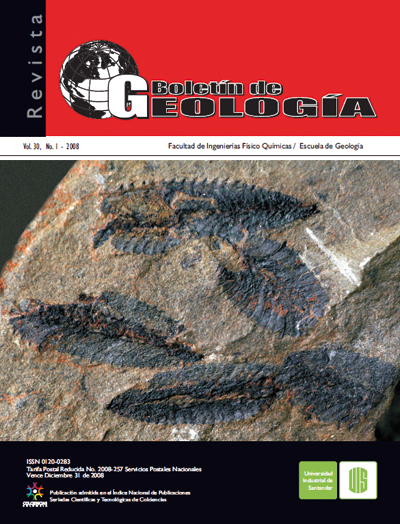RELATIONSHIP BETWEEN FLUVIAL CLASTIC SEDIMENT AND SOURCE ROCK ABUNDANCE IN RAPTI RIVER BASIN OF CENTRAL NEPAL HIMALAYAS
How to Cite
Abstract
Numerosos ríos tributarios aportan sedimentos al río Rapti, a partir de rocas sedimentarias carbonatadas, metamórfcas e ígneas en los Lesser Himalaya, y de rocas sedimentarias clásticas de la cordillera Sub-Himalaya. Se estudio la composición y textura de los sedimentos de barreras fuviales para evaluar los cambios durante el transporte y establecer la relación entre la proporción de clastos y la abundancia de las rocas en las áreas fuente. El porcentaje de clastos de cuarcita o granito se incrementa, mientras que los clastos de carbonatos, esquistos o pizarras decrece con respecto a la distancia de transporte. El tamaño de los clastos decrece corriente abajo, mientras que el índice de aplastamiento y esfericidad tiende a incrementarse. No obstante, la poca disminución en la abundancia relativa de las rocas en las áreas fuente a lo largo del río, la relativa proporción de los correspondientes clastos muestran una rápida reducción (clastos de pizarras o flitas o rocas carbonatadas) o un rápido incremento (clastos de granito). La relación de los clastos de cuarcita o esquistos con su correspondiente roca fuente son estadísticamente signifcativos, sugiriendo, que estos clastos pueden proveer la clave de la abundancia de estas rocas. Entre el 85 y 94% de los clastos de gravas representan tipos de roca de la cordillera Lesser Himalaya, sugiriendo que esta cordillera ha aportado enormes cantidades de sedimentos.
Palabras clave: sedimento fuvial, composición grava, Lesser Himalaya, Sub-Himalaya, Siwalik Range
Downloads
References
Blair, T.C. and McPherson, J.G. 1999. Grain-size and textural classification of coarse sedimentary particles. Journal of Sedimentary Research, 69(1): 6–19.
Cameron, K.L. and Blatt, H. 1971. Durabilities of sand size schist and volcanic rock fragments during fluvial transport, Elk Creek, Black Hills, South Dakota. Journal of Sedimentary Petrology, 41: 565–576.
Cavazza, W., Zuffa, G.G., Camporesi, C. and Ferretti, C. 1993. Sedimentary recycling in the temperate climate drainage basin (Senio River, north central Italy); Composition of source rock, soil profile, and fluvial deposits. In: M. J., Johnson, A., Basu (Eds.), Processes controlling the composition of clastic sediments. Geological Society of America, Special Paper, 284: 247–260.
Dangol, V., Thankur, K.C., Ulak, P.D., Nepali, D.B., Rai, S.M. and Joshi, B.M. 1996. Landslides and Debris flows of July 1993 in the upper Eastern Rapti Basin, Central Nepal. Bulletin of Department of Geology, Tribhuvan University, Kathmandu, Nepal, 5: 61–75.3
DHM 1998. Hydrological records of Nepal, stream flow summary, Department of Hydrology and Meteorology (DHM), Ministry of Water Resources, Kathmandu, Nepal
DMG, 1983. Geological map of western Nepal. Department of Mines and Geology, Kathmandu, Nepal.Folk, R. L. 1955. Student operator error in determination of roundness, sphericity, and grain size. Journal of Sedimentary Petrology, 25: 297–301.
Folk, R.L. and Ward, W.C. 1957. Brazos river bars, a study in the significance of grain size parameters. Journal of Sedimentary Petrology, 27: 3–26
Jones, A.P. 2000. Late Quaternary sediment sources, storage and transfer within mountain basins using clast lithological analysis: Pineta Basin, Central Pyrenees, Spain. Geomorphology, 34: 145–161
Kimura, K. 1994. Formation and Deformation of River Terraces in the Hetauda Dun, Central Nepal; A Contribution to the Study of Post Siwalikan Tectonics. The Science Report of the Tohoku University, 7th Series (Geography), 44(2): 151–181
McPherson, H.C. 1971. Downstream changes in sediment character in a high energy mountain stream channel. Arctic and Alpine Research, 3: 65–79.
Mills, H.H. 1979. Downstream rounding of pebbles-a quantitative review. Journal of Sedimentary Petrology, 49(1): 295–302.
NEA 1989. Second Kulekhani Hydroelectric project, final report on disaster prevention master plan in upper Rapti River Basin. Technical report submitted to Nepal Electricity Authority (NEA) by Nippon Koei Co. Ltd. Consulting Engineering, Tokyo, Japan.
